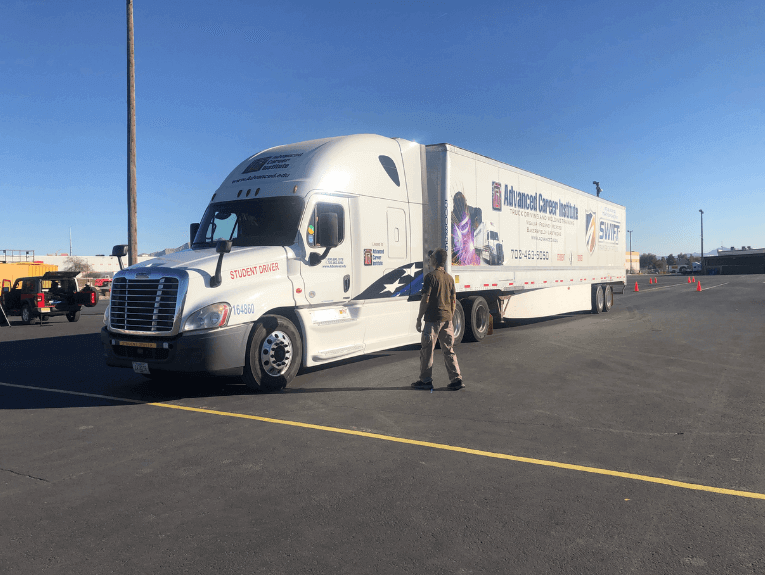Uncategorized
Helpful Information About Potential Welding Careers & Trucking Jobs
-

Building a Safer Future in Welding
Updated June 2025 Welding can be an extremely exciting career, but like with any hands-on job, it’s important to ensure safety during work hours. Welding poses serious hazards such as burns, electric shock, toxic fumes, and eye damage — all of which can lead to long-term health issues. With these in mind, it’s important to prioritize welding safety not only for the individual but also ensure a more efficient, compliant, and professional work environment. This blog will cover several points on how to put your safety first in the welding industry by talking about essential safety, daily tips, and long-term safety practices. Why Does Welding Safety Matter? To explain why you should always practice welding safety it’s important to know what can happen if someone doesn’t make this a priority. According to the U.S. Bureau of Labor Statistics, around 96 welders lose their lives each year due to workplace hazards. This could include burns, electrical shocks, or even amputation of fingers and toes. Welding safety isn’t just about your own personal safety, it’s also about the safety of those working around you as well. Ensuring that you’re following proper safety procedures for everyone in the workplace throughout your workday can create a safer, more efficient workplace. What Are The Most Important Welding Safety Tips? We’ve talked a lot about the bad things that can happen in the welding industry, but there are ways to prevent injury and fatalities in the workplace. From basic personal protective equipment tips to managing ventilation and toxic fumes, we’re going to give you a rundown of all of the ways to stay safe and enjoy your career in welding.Wear the Right PPE
Personal protective equipment, or PPE, is extremely important for welders and will reduce the risk of injury in the workplace. It’s important to protect not only your eyes and face, but also your lungs, skin, and body from fumes, heat and electric shock. To ensure that you’re practicing safe welding, you’ll want to have the following pieces of protective equipment:- Safety Glasses
- Face Shield
- Respirators & Fume Extraction Systems
- Long Heat-Resistant Gloves
- Ear Protection
- Rubber-Sole Boots
Maintain Your Equipment
Routinely checking the equipment being used can ensure that safety concerns are addressed, and workplace accidents happen much less. Even if the equipment was put back in working condition, that doesn’t guarantee it will remain safe. Keeping your area clean is also an important part of maintaining your equipment. This will allow your equipment to not only be safe but will also allow you to function better at your job.Stay Aware of Your Surroundings
Being aware of your surroundings is a critical part of staying safe in any welding environment. Working in this field involves high temperatures, heavy equipment, flammable materials, and other workers operating nearby. All these things could present potential hazards for you. Staying alert and constantly scanning the area, welders can avoid several hazards:- hot surfaces,
- trips and falls over cords and tools
- fire risks or gas leaks.
Practice Fire, Electrical & Ventilation Safety
Fire, electrocution, and toxic fumes are major hazards in the welding industry and are the leading causes of injury in the workplace. Maintaining safety precautions against these types of injuries is very important. One of the easiest ways to prevent fumes and gases from causing harm to welders is to ensure proper ventilation with fans and exhaust vents. It’s also pivotal to wear the proper PPE when working around harmful gases. When it comes to welding, fire and electricity are common tools but can be harmful if not used with the proper safety. In arc welding it’s important to remember that you’re using high voltage electrical equipment that can get extremely hot during the welding process. This means that wearing the proper protective equipment, keeping your station dry, and free of flammable materials are the best ways to prevent injury. Welding is a rewarding and hands-on profession, but with that comes the responsibility of putting safety first – every single day. From wearing the right PPE and keeping your equipment in top shape to staying aware of your surroundings and respecting the risks of fire, electricity and toxic fumes, each step you take toward safety is a step toward a longer, healthier career. Practicing proper safety not only protects you but also builds a stronger, more reliable workplace for your team. When safety becomes part of your daily routine, you’re not just following rules – you’re shaping the future of the trade. Interested in learning welding the safe, professional way? Let’s get you enrolled in our welding program! Contact us today to get started! -

Our New Nevada Campus for Professional Truck Driver Training
Advanced Career Institute is excited to open a CDL Training facility in Las Vegas, Nevada. We saw an opportunity to help train the next generation of professional truck drivers and we could not be happier to expand our training locations. Our Las Vegas campus is located at 4020 E Lone Mountain Rd Suite 100 North Las Vegas, NV 89081. Our staff is ready and excited to work with our students!Las Vegas CDL Training Facility
 Our new campus is designed to give our students the best facility to practice their skills and start their careers in the trucking industry. Students will begin their CDL training by expanding their knowledge about the trucking industry, equipment, and regulations in our newly updated classrooms. Students will then get the chance to practice their driving skills and backing maneuvers on our four-acre paved training yard. For anyone looking to obtain their Class A CDL in Nevada, look no further. ACI's admissions and training staff is ready to help new students get signed up and started on their journey to a great trucking career.
Our new campus is designed to give our students the best facility to practice their skills and start their careers in the trucking industry. Students will begin their CDL training by expanding their knowledge about the trucking industry, equipment, and regulations in our newly updated classrooms. Students will then get the chance to practice their driving skills and backing maneuvers on our four-acre paved training yard. For anyone looking to obtain their Class A CDL in Nevada, look no further. ACI's admissions and training staff is ready to help new students get signed up and started on their journey to a great trucking career.
What To Expect During Truck Driver Training
We have new classes starting every couple of weeks! Students will be able to have a CDL license and a new career in their hands a just a couple of weeks. Our 4-week program is 160 clock hours of training. Our trainers will first prepare students to take their written CDL permit exam. The remaining in-classroom training will be used to learn rules and regulations and the ins and outs of your vehicle. Students will then move onto yard training where they will get behind the wheel of one of our beautiful trucks.How to Get Your Class A CDL in Nevada
- Make sure you meet all of the requirements necessary to get your Commercial Driver's License.
- Contact Advanced Career Institute's Las Vegas Campus to sign up for training.
- Next, obtain your CDL permit. As previously mentioned, when training with ACI, we will help prepare you to take your CDL permit exam during your first two weeks of classroom training.
- You will need to submit a driving record check. Our admissions staff will help you with this step.
- Complete your 160 hours of training with ACI and schedule your CDL exam.
If you are ready to start training for your Commercial Driver's License in Las Vegas, Nevada, we are ready for you! Give us a call today! 702-463-5050
-

Life as a trucker is more and more favorable for women with the chance of equal pay!
Updated November 2022 As the labor market tightens, many women are looking to infiltrate male-dominated industries in search of higher and equal pay. According to a Women in Trucking study, the percentage of female drivers in the trucking industry grew from 2019 to 2022. Female professional drivers increased to 13.7%, a three percent increase from 2019. Many are citing competitive pay as their motive for entrance into the industry. Noticing the discrepancy between the amount of male and female truckers, Ellen Voie began the Women In Trucking Association in 2007. She wanted to create a network of female truck drivers and encourage a more diverse representation of women in the profession. While helping the general public better visualize female truck drivers, Voie hopes that other women will be encouraged to get licensed as well. The association continues to raise awareness of specific issues, such as equal pay, to help bring more women to the industry. They also want to focus on the encouragement of more women in executive and managerial positions. If you are a woman 0r know a woman interested in getting started in the trucking industry, here are some facts you can share with them about the opportunities trucking provides:- Truckers' pay is determined by load, hours, and mileage. Therefore, gender, ethnicity, or age does not affect your earning potential.
- The advancement opportunities for a truck driver are endless, and all depend on your personal hard work.
- With more women grasping at the opportunity for equal pay, we can predict a climbing rate of female employment nationally, which is a small part of acting against female poverty in the United States.
- In addition to pay opportunities, as a trucker, you will get the freedom to travel and see the beautiful country.
-

Refresh your trucking skills and get back on the road!
Career changes and job advances happen to everyone, no matter what industry you are in. Trucking is no different. Maybe the trucking industry is calling you back home. Even if you've been out of the trucking business for a while, we can help restart your career with a CDL Refresher Course. ACI can update your skills and make sure you are confident enough to get back behind the wheel. Check out the reasons you should enroll in a CDL Refresher Course.Tailored to You
Our CDL Refresher Course can be tailored to fit your individual needs. We understand that everyone may have different skill levels and therefore needs a specific course structure. Our refresher course is 3-weeks long and is behind-the-wheel-only. It is designed for students who already hold a California or Nevada CDL permit but have little to no experience behind the wheel of a commercial vehicle.Short Time Commitment
We know that you have already been through extensive training when you first obtained your CDL. Here at ACI, the purpose of our CDL Refresher Course is to help update your knowledge and experience behind the wheel. That is why our course will be a maximum of 3 weeks to get you back on the road.Location Options
The ACI CDL Refresher Course is available at all five of our locations: Visalia, Fresno, Merced, Bakersfield, and Las Vegas campuses. Therefore, you can find an option that works best for you and your schedule.Feel Confident
All of our CDL refresher course is designed to help students feel prepared to take the behind-the-wheel CDL exam. There is no shame in asking for a little bit of help. ACI is here to fit your needs and help you fulfill or get back to your career goals. Contact us today to get back behind the wheel in a short amount of time. -

School is back in session for you too!
It's back to school time for families across the country and it can be back to school for you too! There is no better time to hit the books again. While your kids are trying to move on to the next grade level, you will be moving on to your next career! At Advanced Career Institute (ACI), you can take the first step to a new career in trucking or welding. Still not sure? Check out our list of great reasons to start your training today!- Short Training Time - At ACI, our goal is to get you trained and out in the workforce in a time frame that gets you earning the money you deserve quickly. If you go back to school with ACI, you'll be off to the workforce in 4 weeks for trucking and 38 weeks for welding.
- Job Placement- Going back to school can be scary because of the uncertainty of career placement once you graduate. However, ACI takes care of this worry for you! ACI offers job placement assistance that includes helping your job search, practice for interviews, and spruce up your resume.
- Jobs In Demand - Currently, the trucking industry is one of the most in-demand career paths on the market today. This means jobs are just around the corner for you once your training is complete. Additionally, as a new school year starts, opportunities for school bus drivers will also emerge.
- Tuition Assitance Available - If you go back to school with ACI, you have the possibility to be eligible for financial aid assistance. This assistance can help pay for your training and possibly take away the stress of tuition for you and your family.
- Inspire Your Children- Children look up to and admire their parents. If they see mom and dad are working hard in school, it can encourage your children to do their best in school too! This can turn into wonderful bonding time.
-

Know How Hours of Service Rules May Change Your Schedule
During truck driver training, one of the important topics that you’ll learn about is the HOS Rules, or Hours-of-Service regulations. These are rules that every driver must follow once they receive their CDL. These hours of service refer to the duration for which someone can safely drive, the frequency of required breaks, and the structure of those break periods. During your training, you’ll learn not only the details of these rules, but also why they’re so important.What are the HOS Rules?
The Hour-of-Service rules were created almost 90 years ago by an organization called the Interstate Commerce Commission. Lawmakers developed these rules to create a better work environment for professional truck drivers and others on the road. The goal of the HOS rules was to manage concerns about public safety on the road. Over the years, they’ve evolved into a list of rules for professional truck drivers to work, take breaks, and create a safer behind-the-wheel experience. This includes short-haul exceptions, adverse driving condition exceptions, break requirements, and sleeper berth provisions. Let’s talk about what each of those means.Short-Haul Exception
The short-haul exception is the radius of nautical miles in which a driver can travel without needing to keep a detailed log. This was put in place to make it easier for drivers who operate within a limited radius, as well as to relieve administrative burden. Scenario Marc works for a local grocery store to deliver goods from a warehouse to the stores nearby. Since the trips are within a 100-mile radius, the driver can return home each night, and they don’t need a detailed logbook for their trips. Due to the short distance, Marc complies with the short-haul exception.Adverse Driving Conditions Exception
This particular exception refers to instances of unforeseen road hazards or weather conditions. The adverse driving conditions exception gives drivers an additional two hours when they face delays. Whether it’s a summer storm or accumulating snow, drivers have the flexibility to safely reach their destination or stopping point when they’re met with unexpected circumstances. Scenario Maria is hauling produce from Fresno to Nevada. While traveling to her destination, a snowstorm hits Donner Pass in the Sierra Nevada mountains, bringing traffic to a stop. Maria would normally run out of driving time; however, the Adverse Driving Conditions Exception gives her an extra two hours to safely reach a rest area during hazardous weather.Break Requirements
Like with any other career, taking breaks is a requirement to prevent burnout. The break requirements for professional truck drivers state that they need to take at least 30 minutes of downtime after 8 hours of driving. This allows truck drivers a period of time where the driver is on-duty but not driving to qualify as the required break. The flexibility provided by these break requirements allows truck drivers, as well as others on the road, to travel the roads safely. Scenario Victor has been driving for 8 hours, delivering a cargo from Bakersfield to Phoenix, before he pulls into a truck stop. He decides to stretch his legs, grab a meal, and make calls to home during his 30-minute break. This helps Victor prevent fatigue and allows him time to rest before continuing his remaining drive. This break requirement also allows him to remain in compliance with his Hours of Service Rules.Sleeper Berth Provisions
The sleeper berth, a dedicated sleeping space in the cab of a commercial truck, has been an important addition to the truck driver's amenities over the years. This rule allows drivers to split their off-duty time between the sleeper berth and outside the truck. This is generally split their time by spending 8 hours in the berth and 2 hours outside, or 7 hours in the berth and 3 hours outside. This gives the driver more freedom with their downtime. Scenario Ashley and Johnathon, a married couple who are also team drivers, are moving freight from Florida to Louisiana. During the delivery, Ashley takes the wheel while Johnathon rests in the sleeper berth. This allows them to split their off-duty time – Johnathon can log 7 hours in the sleeper, followed by 3 hours outside of the truck at a rest area. This allows them to flexibly split their time to keep freight moving while they both remain compliant and well-rested.Why do the HOS Rules Matter to New Truck Drivers?
As mentioned previously in the blog, the HOS rules were built into the truck driving profession to ensure safety. Whether it’s the well-being of the driver or the others on the road, ensuring that there are regulations to make the roads safer is a high priority. Creating these regulations that have drivers taking frequent breaks is a big part of highway safety. The Federal Motor Carrier Safety Administration, or FMCSA, strives to eliminate as many fatigue-related accidents as possible, which is why these rules are in place. They were also put in place due to the ever-evolving workplace expectations. The Department of Transportation has worked to ensure that professional truck drivers experience flexibility with their careers. Allowing drivers ample opportunity to take their once-a-week 34-hour break has allowed them to fully reset their schedule. Technological advancements have also impacted the truck driving industry’s regulations. With the adoption of electronic logging devices, or ELDs, drivers were able to automatically track their hours of service. This includes their time driving, ensuring they remain compliant with these regulations. To learn more about ELDs and the rules surrounding them, this FMCSA article can answer your questions. Regulators have expanded truck drivers' flexibility over almost 90 years of evolving rules. Creating regulations to allow for longer breaks, as well as the ability to divide breaks between in-cab and off-duty time, has given truck drivers more freedom. At Advanced Career Institute, we focus on training qualified CDL drivers who are employable and safe. The truck driving industry is a high-demand industry, and these Hours of Service rules have become part of the job over the years. If you think that the life of a truck driver is for you, let us help you take the first step!

